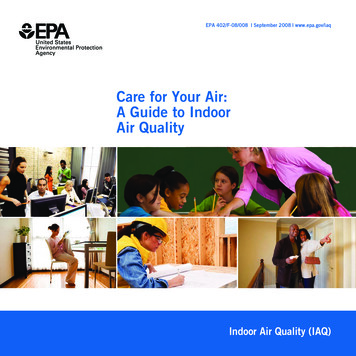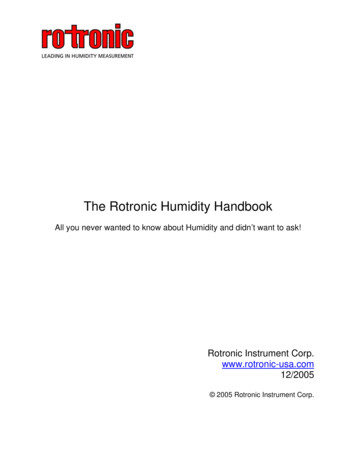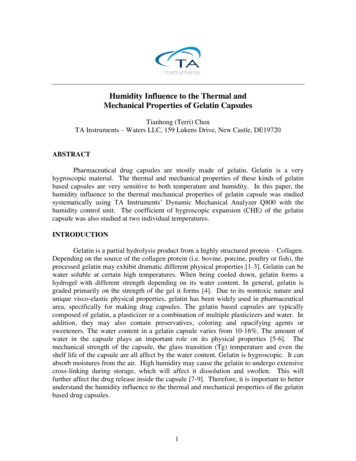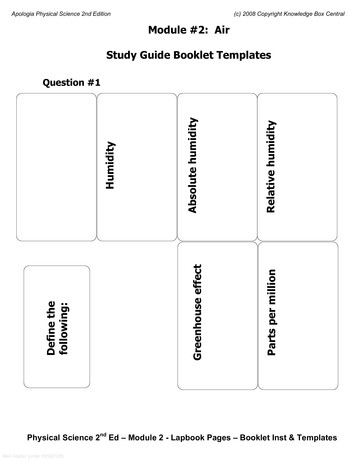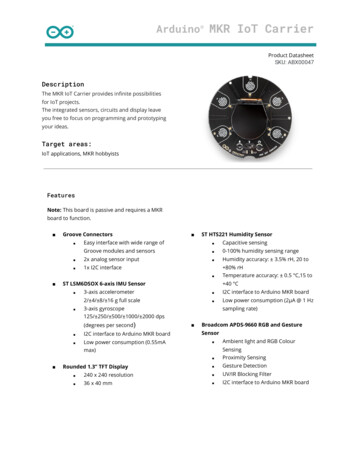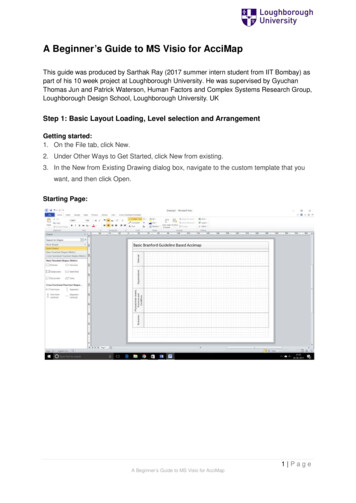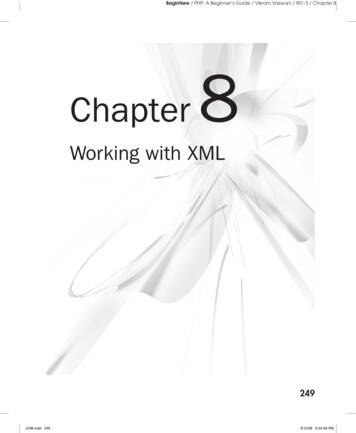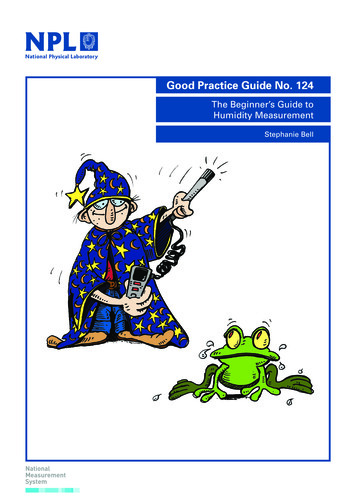
Transcription
Good Practice Guide No. 124The Beginner’s Guide toHumidity MeasurementStephanie Bell
Measurement Good Practice Guide No. 124The Beginner’s Guide to HumidityStephanie BellNational Physical Laboratory
Queen’s Printer and Controller of HMSO, 2012.ISSN 1368-6550September 2012National Physical LaboratoryTeddington, Middlesex, United Kingdom, TW11 OLWExtracts from this report may be reproduced provided the source is acknowledged andthe extract is not taken out of context.
NPL Measurement Good Practice GuidesThis is one of a series of NPL guides about measurement. These guides are aimed ateveryone who has an interest in measurement, whether in a laboratory, factory,hospital, university, college or in any other walk of life.The series includes beginner’s guides, which introduce measurement concepts,methods and practices at a basic level. More specialised guides cater for measurementprofessionals and practicing scientists and engineers who want to go more deeply intoan area of measurement. References to additional guides or reading are given whereappropriate.All these guides aim to promote good practice in measurement, and are produced withtechnical input from specialists in the particular subject covered.NPL is the UK’s national measurement institute. It aims to deliver the highesteconomic and social benefits through world-leading and responsive science andknowledge services. This series of NPL Good Practice Guides provides one way totransfer knowledge to people who need to make better measurements.For more urementproblemsvisit
Introduction to measurementMeasurement underpins science, technology and industry. It enables processes to berun efficiently, and innovative and competitive products to be made. It impactsstrongly on the welfare of a modern society and touches almost every aspect of dailylife.A measurement tells us about a property of something. It might tell us how heavy anobject is, or how hot, or how long it is. A measurement gives a number to thatproperty, expressed in the appropriate unit.The units of measurement are standardised. The International System of Units (SI) isused worldwide so that measurements can be consistent everywhere.Measurements are only ever estimates. Every measurement is subject to someuncertainty. Perfect measurements cannot be made and so the true value is neverknown exactly. The uncertainty of a measurement expresses how good the estimate isthought to be.A measurement result is incomplete without a statement of uncertainty. It is thereforein three parts: a number, a unit of measurement, and an uncertainty. For example, alength may be measured as 2.3 cm 0.1 cm.The uncertainty of a measurement should suit the need: a school clock need not haveatomic accuracy.Measuring equipment should be calibrated by comparison against a suitable referencewhich itself has been calibrated. An unbroken chain of calibrations linking back to anational standards body such as the National Physical Laboratory (NPL) is known asmeasurement traceability.Good measurement practice can reduce uncertainty and so improve the quality ofprocesses and products.
ContentsNPL Measurement Good Practice Guides . 3Introduction to measurement . 40About this guide . 11Introduction . 11.1 What is humidity? . 11.2 Why is humidity important? . 12Some humidity concepts . 22.1 What qualities does water vapour have? . 22.2 How do we quantify humidity?. 22.3 Other important humidity concepts . 33Humidity-measuring instruments - hygrometers . 43.1 Hygrometer types . 43.2 Air temperature measurement . 54How to measure humidity . 64.1 Selection of an instrument . 64.2 Other points to consider . 74.3 Measurement set-up - sampling . 74.4 Recording humidity measurement results . 85Some humidity measurement examples . 96Calibration and traceability of measurement . 106.1 Calibration. 106.2 Uncertainty of measurement . 117Humidity measurement: some do’s and don’ts . 128What can go wrong - troubleshooting . 139Special cases . 1410Humidity calculations and conversions . 1510.1Tables . 1510.2Humidity calculations . 1711Further reading . 1812Keywords and definitions for humidity . 19
0About this guideThis is a guide to humidity measurement for beginners. It introduces the concept ofhumidity, and the basics of making a reliable humidity measurement.1Introduction1.1What is humidity?Humidity is the presence of water vapour in air (or any other gas). In normal room airthere is typically about 1 % water vapour, but it is widely present in greater or lesseramounts. High humidity makes hot days feel even hotter. Low humidity can givepeople a feeling of a dry throat, or sensations of “static” when touching things.Humidity is measured using a hygrometer.1.2Why is humidity important?Humidity affects many properties of air, and of materials in contact with air. Watervapour is key agent in both weather and climate, and it is an important atmosphericgreenhouse gas. A huge variety of manufacturing, storage and testing process arehumidity-critical. Humidity measurements are used wherever there is a need toprevent condensation, corrosion, mould, warping or other spoilage of products. This ishighly relevant for foods, pharmaceuticals, chemicals, fuels, wood, paper, and manyother products.Air-conditioning systems in buildings often control humidity, and significant energymay go into cooling the air to remove water vapour. Humidity measurementscontribute both to achieving correct environmental conditions and to minimising theenergy cost of this.One of nature’s hygrometers:pine cones open at low humidityto release their spores.Source: NPL1
2Some humidity conceptsSome main concepts are outlined below, and there is a list of keywords anddefinitions at the end of this Guide.2.1What qualities does water vapour have?Water vapour is normally invisible, and behaves like a gas, except when it condensesto form water or ice. Even without condensing, water vapour can react with surfacesand penetrate materials. The capacity of a gas (or a space) to hold water vapourdepends on its temperature: the higher the temperature, the more water vapour it cancontain.2.2How do we quantify humidity?Humidity is expressed in several different ways (see also the keywords at the end ofthis Guide).Relative humidity – how saturated a gas (or a space) is with water vapour. This is themost commonly used measure of humidity. Usually expressed as a percentage, withthe symbol “%rh”, for example “The humidity is 51 %rh”. The term “relativehumidity” is commonly abbreviated to RH (note this is different from the unitsymbol: %rh).Interaction of water vapour with materials is often in proportion to relative humidity.Dew point (or dew-point temperature) - the temperature at which condensation(dew) would occur if a gas were cooled. Dew point is a useful measure for tworeasons: The dew point tells us what temperature to keep a gas, to prevent condensation Dew point is an absolute measure of the gas humidity (at any temperature) andrelates directly to the amount of water vapour present (partial pressure of watervapour).Dew point is expressed in temperature units, for example “Today the dew point in myoffice is 10 C.” If the condensation would be ice (below 0 C) then the term frostpoint is used.Fraction or ratio – the proportion of water vapour in a gas. This can be given interms of mass, volume or amount of substance (moles).Concentration – the amount or mass of water vapour per unit volume, for exampleroom air might typically contain about 10 grams of water vapour per cubic metre.2
2.3Other important humidity conceptsSaturation – When a gas (or a space) holds the maximum water vapour possible at agiven temperature, it is said to be saturated. If extra water is added to a saturated gas,or if its temperature is reduced, some of the water vapour will condense.Partial pressure – A gas mixture such as air is made up of several pure gascomponents (such as oxygen, nitrogen and others). The total pressure of the gas issaid to be the sum of partial pressures of the component gases. In room air, the partialpressure of water vapour might be around 1000 pascals (Pa). (Compare this to typicalatmospheric pressure, which is around 100 000 Pa.)Saturation vapour pressure (SVP) – the maximum partial pressure of water vapourthat can occur. At any given temperature, there is an upper limit to how much watervapour a gas (or space) can contain. For example, at 20 C, the saturation vapourpressure of water is around 2500 Pa.Supercooled water – liquid water below the normal freezing temperature.Occasionally dew occurs as supercooled water below 0 C (freezing to iceeventually).Dew, or condensation.Source: NPL3
3Humidity-measuring instruments - hygrometers3.1Hygrometer typesBecause so many things are influenced by humidity, it follows that there are verymany effects that can be used to measure it. Some main methods are as follows:Relative humidity sensor (electrical impedance) - hygrometer based on anelectronic component that absorbs water vapour according to air humidity, andchanges electrical impedance (resistance or capacitance). The instrument is usually inthe form of a “probe” attached directly, or by a cable, to electronics unit to display therelative humidity reading.Condensation principle hygrometer - hygrometer using cooling to induce controlledcondensation. The stable temperature at which this occurs is measured and reportedas dew point or frost point. A usual format is a cooled mirror with optical detection ofcondensation used as feedback to control the mirror temperature.“Dew-point” probe - hygrometer based on an electronic sensor changing electricalcapacitance on absorbing water, capable of measuring trace levels of water vapour invery dry gases. Often scaled in units of dew point (or frost point) – hence theinstrument name – but readings can be displayed in other terms.Psychrometer (wet- and dry-bulb hygrometer) - Hygrometer using evaporativecooling as a measure of humidity. A dry thermometer is compared against onesheathed in a wet wick, in moving air. The paired temperature values can be used tofind the humidity using tables or by calculation (sometimes internally calculated anddisplayed directly by modern psychrometers).Mechanical hygrometer - hygrometer using change in length of hair (hairhygrometer) or other organic material to measure humidity. Some types record on achart driven by clockwork or batteries. Very basic types are not powered at all.Electronic sensor-based hygrometers are usually preferred now, but many mechanicalhygrometers remain in use for room monitoring.4
A wide variety of other humidity sensing principles are used Hygrometer typeSensing principleAbsorption spectrometerInfrared light absorption by water vapourAcousticHumidity-dependent acoustical transmission or resonanceAdiabatic expansion“Cloud” formation in chamber on expansion cooling of samplegasCavity ring-downspectrometerDecay time of absorbed, multiply-reflected infrared lightColour changeCrystals or inks using cobalt chloride or other chemicalschanging colour with hydrationCondensationTemperature of formation of water or ice, on cooling humid airElectrical impedanceRelative humidity sensor – electrical change on absorption ofwater vapour into (typically) polymer film“Dew-point” probe – electrical change on absorption of watervapour into (typically) porous metal oxide film.Electrolytic (phosphorouspentoxide)Electric current proportional to dissociation of water intohydrogen and oxygenGravimetricBy weighing - mass of water gained or lost by humid air sampleMechanicalDimensional change of humidity sensitive material (hair,polymer, paper )Optical fibreChange in reflected or transmitted light, using hygroscopiccoating, or optical gratingQuartz crystal resonatorChange in resonant frequency due to mass of surfaceadsorbed waterSaturated lithium chlorideConductivity of hygroscopic saltWet- and dry-bulb(psychrometer)Humidity-dependent evaporative cooling of wetted surfaceZirconiaHumidity derived from oxygen content of gas3.2Air temperature measurementAir temperature is a key measurement alongside relative humidity. This is becausethe “relative” aspect is effectively “relative to temperature” (how saturated the gas isat its current temperature). For a given air sample, a rise in temperature means a fall inrelative humidity. For example, at a humidity of 50 %rh, a temperature rise from20 C to 21 C will cause relative humidity to fall by about 3 %rh. Because of this(and because temperature is usually of interest anyway) relative humidity instrumentsgenerally have integral temperature sensors.5
4How to measure humidity4.1Selection of an instrumentConsider: What you want to measure – is it relative humidity, dew point, or somethingelse? Many instruments display results converted into several alternative unitsbut the measurement will be intrinsically just one of these. What humidity range, and what temperature range. Must it survive extremeconditions – very dry, hot or wet? Instrument performance needed (resolution, short-term stability, long-termdrift, speed of response, non-linearity, hysteresis, temperature coefficient,uncertainty of calibration) Configuration – a hygrometer probe measuring in free space, or will humidgas be supplied through tubing to flow through the instrument? Hand-held,bench-top, or surface mounted. Any space constraint? Power – battery, mains electricity or even unpowered. Data output format - display, analogue voltage or current, digitally-read output(RS232 ) or data logged and stored, to be downloaded later. Someinstruments can record on paper charts. An instrument that gives an electricaloutput (analogue or digital) but no displayed result is sometimes called a“transmitter”. Are any “alarms” needed if humidity passes any limit? Is sensor output to be used toautomatically control something? Compatibility with any unusual gases Contamination such as dust orchemicals Use in hazardous areas (may requirespecial design and certification) Robustness Cost and upkeep Calibration Versatility Interchangeability Ease of use or level of skill requiredChoosing a hygrometer involvessome decisions and possibly others!6
4.2Other points to considerOnce you have your hygrometer, some other actions follow: Operating procedures, and staff training if needed Maintenance (if any) Initial calibration, and repeat calibrations at intervals Other checks in between calibrations. This is particularly important when ahygrometer has been exposed to extreme conditions, or mistreated, orwhenever there is doubt about whether it is reading correctly.4.3Measurement set-up - samplingSampling format of a hygrometer can mean its configuration (a probe may samplefree air, or a flow of gas is sampled through a tube).More generally, correct sampling is about making sure the measurement isrepresentative of the condition you want to measure. Avoid water being spuriouslyadded to the measured gas (for example, don’t measure near pooled water). Avoidunintended removal of water from sample gas (for example, don’t have accidentalcondensation in tubing upstream of the hygrometer). Wherever there is a risk ofcondensation, localised heating (such as electrical “trace heating” of sample tubing)protects against this, by keeping the gas above condensation temperature (above thedew point or frost point).For measuring very dry gases (frost points around -40 C, -50 C, or below; watervapour fraction around 100 parts per million, or less), sample tubing and all materialsin the gas flow path are critical. In this range, even tiny amounts of stray waterreleased from surfaces can significantly add to the gas moisture content, and can givebadly misleading results. To avoid this, use clean, moisture-neutral materials;smallest possible volume of pipework; and long flushing times. Sometimes heating isused to drive off traces of surface water. If using a pump – suck, don’t blow. Put thepump at the far end (outlet) of a system, to avoid contamination.For a relative humidity measurement, the temperature must be representative too.Measuring at a “cold spot” in a room can give an over-estimate of the typical relativehumidity, even though water vapour might be evenly spread across the space.If conditions are varying (such as often happens under cycling control of an airconditioning system), take repeated readings over a period of time to get an idea of7
typical range. From repeated readings, you can calculate an average or mean. This canalso reduce the uncertainty due to short-term instability of the instrument.4.4Recording humidity measurement resultsSome hygrometers have internal data logging. In other cases they are read using acomputer (by connection, or even wirelessly). Otherwise, records depend on a personreading and writing down results.Always record the humidity value and units. For relative humidity measurements,temperature is usually essential. Pressure must be known for psychrometers, andsometimes for other cases (such as measurements in compressed air lines – especiallyif planning to convert to equivalent at atmospheric pressure).As with all measurements, it is also good practice to record the date, time, place,method, operator, and anything else that allows the measurement to be understoodlater.Measuring humidity correctly takes someskill and judgement8
5Some humidity measurement examplesA few basic examples of how instruments might be used in particular applications areas follows:Room humidity monitoringRequirement: Long-term record of temperature and humidity in a moderate rangeConsider: Unsupervised operation? Would data at intervals be enough e.g. hourly?Real-time information needed, or record to view later?Possible solution: Automated “data logger” whose readings can be downloadedeasily to a computer.An industrial ovenRequirement: Humidity measured at high temperatures to show progress of heattreatment such as drying or baking.Consider: Will there be dust, or other vapours apart from water?Possible solution: Relative humidity probes can be used (but only those specifiedfor high temperatures). It may be possible to extract a sample flow of gas to a coolertemperature (but avoiding condensation). Check sensitivity to any chemicals givenoff during heating.A compressed air supply lineRequirement: Monitor air supply inside a pipeline to confirm level of dryness. Mayhave some level of dust or oil in the gas streamConsider: Unsupervised use? Reading remotely? Any alarms needed?Possible solution: Typically a dew-point capacitive probe would be used. The sensorusually has a sintered filter (and upstream filtering of the gas flow may help to protectthe sensor). Dew-point probes vary in their speed of response and long-termperformance.Note: The dew-point reading in a pressurised gas line is known as “pressure dewpoint”. The same gas expanded to atmospheric pressure would have a lower dewpoint.A climatic test chamberRequirement: A range of temperatures and humidities. May need to track rapidchanges. There may be condensation at times (depending on the test performed).Consider: Response time. Robustness of instrument at hot and wet extremes. Checkthe actual planned range of test conditions.Possible solution: A few relative humidity sensors (probes) are designed to cope witha wide humidity and temperature range. Wet- and dry-bulb hygrometers(psychrometers) can be suitable, although they need careful setting up andmaintenance.9
6Calibration and traceability of measurement6.1CalibrationLike all measuring instruments, hygrometers don’t always read exactly true. They cansuffer from bias and long-term drift. Therefore calibration is essential for accuratehumidity measurement.Calibration is the comparison of an instrument against a reference value. For ahygrometer, this comparison might be against a calibrated reference hygrometer,using a chamber or other stable source of humid gas. The reference hygrometershould itself have a calibration traceable directly, or in multiple steps, back to anauthoritative standard. This is known as measurement traceability.Some users assume that calibration will leave an instrument “reading right”. Notnecessarily – calibration is not the same as adjustment.A calibration certificate reports any instrument errors, and gives the uncertainty inthese. Calibration corrections then need to be applied to instrument readings (or elsetaken into account as a source of uncertainty). With any measurement, the practicaluncertainty in using the instrument is always more than on the calibration certificate.Calibrations against reference hygrometers, using humidity generators, can be done inlaboratories. A calibration lab may have accreditation (through UKAS in the UK)giving assurance that calibrations are traceable and competently performed. For somehygrometers there are also methods of “field calibration” - for example using saltsolutions to generate values of relative humidity – which can also be made traceable.Calibrations need to be repeated, because hygrometers can drift - due to conditions ofuse, or just due to sensor ageing. Choosing how often to calibrate depends on usage,risk of drift, and how critical the measurement is. Relative humidity instrumentsmight be calibrated every 6 to 12 months (or more often if they are harshly treated).A reference hygrometer in a lab might be calibrated every 1 to 2 years.Some calibration tips: Calibrate in terms of the quantity to be measured (such as relative humidity, ordew point, or other ) Calibrate probe and hygrometer together (unless clearly advised otherwise bythe manufacturer). Calibrate for the range and conditions of use10
Especially for dew-point probes used for more than one pressure or gas type,check whether calibration in air at atmospheric pressure is applicable(particularly for units expressed as mass or volume).A check is not a calibration. But checks against another instrument (ifavailable) are highly useful. A check can help in assessing whether ahygrometer is functioning as expected, and whether repair or recalibration isneeded.A check is not a calibration, but can be useful6.2Uncertainty of measurementEvery measurement is subject to some uncertainty, expressed as “ ”, at a level ofconfidence (usually 95 %). For example, “50 %rh 3 %rh at a level of confidence of95 %” means we are 95 percent sure the true value is between 47 %rh and 53 %rh.Uncertainty in humidity measurement can come from various causes. It dependspartly on the hygrometer, which might suffer from drift, short-term “noise”, limitedresolution . Calibration uncertainty needs to be taken into account. If the conditionbeing measured is unstable, this too contributes to uncertainty in the result – forexample, temperature changes can cause uncertainty in relative humidity values.There is no “typical uncertainty” for a humidity measurement. But very broadly inideal conditions, relative humidity measurements might achieve uncertainty within 2 %rh to 3 %rh. Under difficult conditions this could be 5 %rh to 10 %rh, oreven worse. The best dew-point measurements could be as good as 0.05 to 0.1 C, in a lab, using the best condensation hygrometers. In worse conditions, and usingless sophisticated dew-point probes, uncertainty of several degrees is not unusual,especially at very dry levels (all uncertainties at 95 % confidence).11
7Humidity measurement: some do’s and don’tsDo Make use of the manual, and of manufacturer’s advice Have the instrument calibrated, and take account of any calibration correctionsrequired Let the instrument reach the temperature of the location Allow time for the humidity reading to stabilise (especially for dry gases) Record measurement results with suitable care Be clear when expressing humidity differences. A change of 10 % of readingis not the same as a change of 10 %rh. Check any hygrometer that has been exposed to extreme conditions orcontaminantsDon’t Don’t handle humidity sensors roughly. Don’t abuse well-mounted sensors bytreating them as coat hooks!Don’t use sensors outside the temperature or humidity range specified by themanufacturer – this could cause a shift in calibration.Don’t expose sensors to condensation - unless you know they are candefinitely tolerate thisDon’t “mix and match” humidity probes with different electronics units –unless they are definitely designed for this. Instrument suppliers can advise ifa probe is a “self-contained” interchangeable unit with its own signalprocessing insideWatch out for Droplets, or stray water in any form: if present, humidity measurements maybe misleadingDust – most instrument typesPressure differences (dew point) or temperature differences (relative humidity)12
8What can go wrong - troubleshootingIf you suspect hygrometer readings may be incorrect: Make sure all equipment is switched on and all cables are connectedConsider whether the hygrometer and the conditions have had long enough tostabiliseCheck that the temperature is as expected (particularly for relative humiditymeasurement).Check the most recent calibration certificate, in case the hygrometer simplyhas a large calibration error. If so, applying a suitable calibration correctionshould bring the result to a realistic value.Consider comparing against another hygrometer as a check.Beware of human error mistakes in recording, mis-reading, wronglynumbering sets of sensors If you suspect a problem, check the obvious13
9Special casesBe prepared to seek advice - some humidity measurements need special care:Temperature change - if measuring gas at one temperature and using it at another,measured values may need converted or interpreted. In particular, relative humidityfalls when temperature rises (and rises when temperature falls).Pressure change – if measuring at gas at one pressure and using it at another,measured values may need to be converted or interpreted. Some humidity parameterschange when gas is expanded (examples are: dew point and mass of water per unitvolume).Low (vacuum) pressures – humidity measurements can be made below atmosphericpressure, but need some thought to set up and interpret.Non-air gases – humidity is measured in a wide variety of gases, such as fuel gas(“natural gas”) and various process gases. Take care to choose a measurement methodsuitable for the particular gas. Beware of humidity readings displayed in units that aregas-dependent, and be ready to interpret (convert) for the gas used. Wherever unitsrelated to mass, or volume (“ppm”) are displayed, they may be internally calculatedwith an assumption of measuring in air.Special cases can be interesting Harsh environments – Dust, vibration, condensation, airborne droplets, chemicals all pose challenges to most hygrometers.14
Older hygrometers – modern electronic humidity sensors have increasingly longlifespans, if treated well. If you are using a relative humidity sensor or dew-pointprobe that you know to be old, don’t expect the best performance. Some olderhygrometers may suffer from drift, slowed response, etc.10Humidity calculations and conversionsJust a few tables are given here, to give some idea of scale and conversions betweenhumidity values in different units. See the Further Reading section for sources ofmore detailed information.10.1 TablesAir temperature, dew point, and relative humidityApproximate values of relative humidity are shown for a selection of dew points andair temperatures.Table 1. Values of relative humidity at selected temperatures and dew pointsAirtemperature / CDew-pointtemperature / C051015202530354050051015202530354050100 70 50 36 26 19 14 118- 100 71 51 37 28 21 16 12- 100 72 53 39 29 23 17100 73 54 40 30 23- 100 74 55 42 32- 100 75 56
This is a guide to humidity measurement for beginners. It introduces the concept of humidity, and the basics of making a reliable humidity measurement. 1 Introduction . 1.1 What is humidity? Humidity is the presence of water vapour in air (or any other gas). In normal room air
